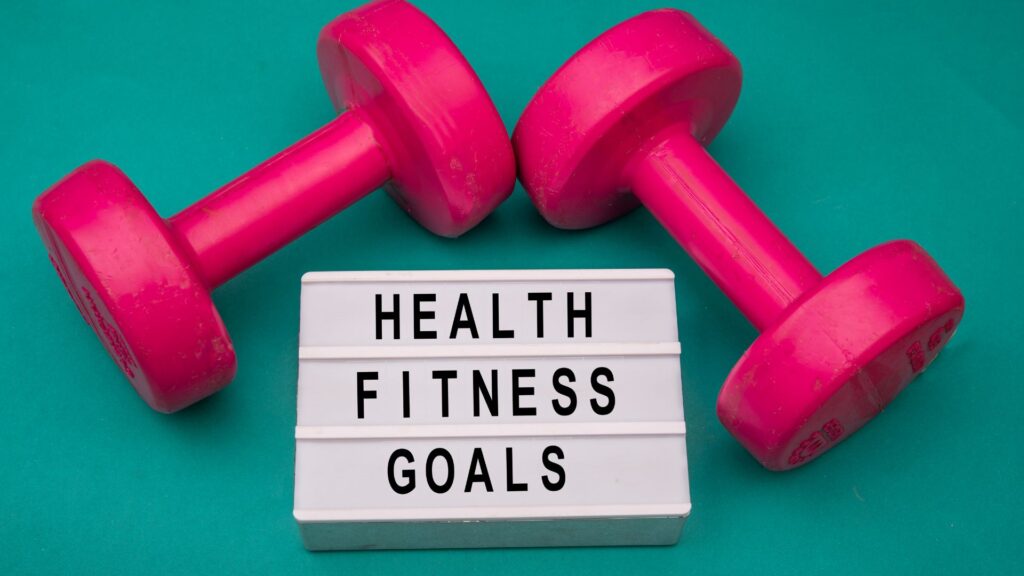Health and Fitness Guide – Are you tired of living a sedentary lifestyle and looking to embark on a journey towards better health and fitness? You’re not alone! Many people want to make a positive change in their lives by adopting a healthier lifestyle, but knowing where to start can be overwhelming.
In this beginner’s guide to fitness, we’ll take you through the essential steps to kickstart your fitness journey, improve your overall well-being, and make lasting changes. So, lace up your sneakers and let’s get started on the road to a healthier you!
Understanding the Basics of Health and Fitness
Setting Clear Goals
Before you dive headfirst into a fitness routine, it’s crucial to set clear and achievable goals. Whether your aim is to lose weight, build muscle, increase endurance, or simply feel more energized, having well-defined objectives will keep you motivated and on track.
Assessing Your Current Fitness Level
Knowing where you currently stand in terms of fitness is essential. You can do this by assessing your strength, flexibility, cardiovascular endurance, and body composition. This evaluation will help tailor your workout plan to your specific needs.
Getting Started with Exercise
Choose Activities You Enjoy
Fitness doesn’t have to be a chore! Select activities that you genuinely enjoy, whether it’s dancing, hiking, swimming, or playing a sport. This makes the process more enjoyable and sustainable.
Start Slow and Gradual
For beginners, it’s vital to start slowly to prevent injuries. Gradually increase the intensity and duration of your workouts as your fitness level improves.
Mix Cardiovascular and Strength Training
A balanced fitness routine should include both cardiovascular exercises (like jogging or cycling) and strength training (using weights or resistance bands). This combination helps you burn calories, build muscle, and boost overall fitness.
The Importance of Nutrition
Balanced Diet
Exercise alone won’t yield the desired results without proper nutrition. Consume a balanced diet rich in fruits, vegetables, lean proteins, and whole grains. Stay hydrated by drinking plenty of water.
Portion Control
Keep an eye on portion sizes to avoid overeating. Eating mindfully can help you maintain a healthy weight and support your fitness goals.
Staying Consistent
Create a Workout Schedule
Consistency is key to success in your fitness journey. Create a workout schedule that fits your lifestyle, and stick to it as closely as possible.
Find an Accountability Partner
Working out with a friend or hiring a personal trainer can provide the accountability you need to stay committed to your goals.
Overcoming Challenges of Health and Fitness
Listen to Your Body
If you experience pain or discomfort during exercise, don’t push through it. Listen to your body and adjust your workout accordingly to prevent injuries.
Manage Stress
Stress can hinder your progress. Incorporate stress-reduction techniques like meditation or yoga into your routine to maintain mental well-being.
Celebrate Your Progress
Track Your Achievements
Keep a journal to record your workouts and nutrition. Celebrate your achievements, no matter how small they may seem.
Reward Yourself
Treat yourself with non-food rewards when you reach milestones. It can be a new workout outfit or a relaxing spa day.
Setting Clear Goals of Health and Fitness
When you decide to embark on a fitness journey, one of the first and most crucial steps you can take is setting clear and achievable goals. These goals serve as your roadmap, guiding you towards the healthier and fitter version of yourself.
Now, you might be wondering, why are clear goals so essential?
- Motivation: Clear goals provide you with a strong sense of motivation. When you have a specific target in mind, whether it’s losing a certain amount of weight, running a 5k race, or being able to do a certain number of push-ups, it gives you something to strive for. This motivation will help you stay committed to your fitness routine, even on those days when you’d rather stay in bed.
- Focus: Goals help you stay focused on what’s important. In the world of fitness, there’s a lot of information and many workout routines to choose from. Having clear goals narrows down your choices and helps you select the exercises and dietary habits that align with your objectives.
- Measuring Progress: Goals provide a way to measure your progress. Imagine you’ve set a goal to lose 20 pounds. As you make your way towards that target, you can track how many pounds you’ve shed, helping you see the tangible results of your efforts. This sense of accomplishment can be incredibly satisfying and motivating.
- Accountability: When you share your goals with friends, family, or a fitness buddy, it creates a sense of accountability. You’re more likely to stick to your plan when others know what you’re trying to achieve. Plus, they can offer support and encouragement along the way.
- Adaptability: Goals aren’t set in stone. If you find that your initial goals are too ambitious or not challenging enough, you can adjust them as you go. The ability to adapt your goals allows you to stay on the right track even if circumstances change.
Now, how do you set clear fitness goals? Here’s a simple framework to get you started:
Specific: Your goals should be clear and specific. Instead of saying, “I want to get in shape,” try, “I want to lose 15 pounds in the next three months.”
Measurable: Make sure your goals are measurable so that you can track your progress. For instance, you can measure weight loss, the number of miles you can run, or the amount of weight you can lift.
Achievable: While it’s great to aim high, make sure your goals are realistic. Setting unattainable goals can lead to frustration and disappointment.
Relevant: Ensure your goals are relevant to your overall fitness journey. They should align with what you truly want to achieve.
Time-Bound: Set a timeframe for your goals. This adds a sense of urgency and prevents procrastination. For example, “I want to complete a 5k run in two months.”
In summary, setting clear and well-defined fitness goals is the first step towards a healthier you. These goals will keep you motivated, focused, and accountable on your journey to better health and fitness. So, take some time to think about what you want to achieve, write it down, and get started on your path to a healthier lifestyle.
Assessing Your Current Fitness Level
Assessing your current fitness level is a crucial step on the road to a healthier you. It’s like taking a snapshot of where you are right now so that you can plan your journey effectively. Here’s why it matters:
- Personalized Approach: Everyone’s fitness starting point is different. By assessing your current fitness level, you can tailor your exercise and nutrition plan to your unique needs and capabilities. This ensures that you’re not pushing yourself too hard or setting unrealistic expectations.
- Safety First: Safety should always come first in fitness. If you jump into a rigorous workout routine without knowing your current limitations, you risk injury. Assessing your fitness level helps you identify any physical limitations or health concerns that you need to address before diving into intense workouts.
- Tracking Progress: Just like setting clear goals, assessing your fitness level provides a baseline for tracking your progress. It’s incredibly satisfying to see how far you’ve come since you started your fitness journey. Whether it’s measuring improved flexibility, increased stamina, or decreased body fat, these assessments can be motivating and show you that your efforts are paying off.
- Preventing Plateaus: As you get fitter, your body adapts to exercise. If you don’t reassess your fitness level periodically, you might hit a plateau where your progress stalls. Assessments can help you identify these plateaus and adjust your routine to keep making gains.
Now, let’s talk about how you can assess your current fitness level:
- Cardiovascular Fitness: Measure your cardiovascular endurance by performing exercises like walking, jogging, or cycling. Note how long you can sustain these activities without feeling exhausted.
- Strength: Test your muscular strength by performing basic exercises like push-ups, squats, or planks. How many repetitions or how long you can hold these positions is a good indicator of your strength.
- Flexibility: Assess your flexibility by performing stretches. Reach for your toes, try to touch your toes while keeping your legs straight, and test other basic stretches to see how flexible your muscles and joints are.
- Body Composition: Determine your body composition by measuring your weight, body fat percentage, and waist circumference. This gives you a clear picture of your current body composition.
- Health Check: Consider getting a health checkup with a healthcare professional. They can assess your overall health, including factors like blood pressure, cholesterol levels, and any underlying medical conditions that might affect your fitness journey.
Remember that assessing your fitness level isn’t about passing or failing a test; it’s about understanding where you are right now so that you can make informed choices on your fitness journey. Once you have this information, you can set realistic goals, choose appropriate workouts, and monitor your progress effectively.
It’s a crucial step towards achieving your fitness aspirations and becoming a healthier, fitter version of yourself.
Choose Activities You Enjoy
Embarking on a fitness journey doesn’t have to feel like a chore. In fact, it should be an enjoyable and rewarding experience. One of the keys to long-term success in fitness is selecting activities that you genuinely like. Here’s why it matters:
Sustained Motivation
When you choose activities you enjoy, staying motivated becomes much easier. Rather than dreading your workouts, you’ll look forward to them. Whether it’s dancing, hiking, swimming, or playing a sport, doing something you love makes you more likely to stick with it over the long term.
Consistency is Key
Consistency is crucial for achieving your fitness goals. If you enjoy your workouts, you’re more likely to make exercise a regular part of your routine. You won’t have to rely solely on willpower because your enthusiasm for the activity will drive you forward.
It Doesn’t Feel Like Work
Exercise should be fun, not a punishment. When you engage in activities you enjoy, it doesn’t feel like you’re “working out.” Instead, it becomes an enjoyable pastime. This shift in mindset can have a significant impact on your overall fitness journey.
Variety and Exploration
Choosing activities you enjoy opens up a world of fitness possibilities. You can explore different sports, classes, or fitness routines until you find what resonates with you. This variety keeps things interesting and prevents boredom.
Reduces Stress
Exercise should be a stress-reliever, not a stress-inducer. Activities you enjoy can have a positive impact on your mental well-being, helping you manage stress more effectively.
Social Aspect
Many enjoyable fitness activities are social in nature. Joining a group or team that shares your interests can provide a sense of community and support, making your fitness journey even more enjoyable.
Remember that there’s no one-size-fits-all approach to fitness. What works for one person may not work for another. The key is to experiment and find activities that resonate with you. Whether it’s dancing to your favorite music, taking scenic hikes, or participating in team sports, the options are vast.
So, don’t be afraid to try new things and discover what makes you excited to move. Fitness should enhance your life, boost your energy, and leave you feeling fulfilled. When you choose activities you enjoy, you’re on the path to a healthier you, and you’ll be more likely to stick with it for the long haul.
Start Slow and Gradual
When it comes to embarking on a fitness journey, the old adage “slow and steady wins the race” holds true. Here’s why beginning your fitness routine slowly and gradually is so important:
Injury Prevention
Starting with high-intensity workouts or pushing your body too hard from the get-go can lead to injuries. It’s crucial to give your muscles, joints, and connective tissues time to adapt to new physical demands. Beginning slowly reduces the risk of strains, sprains, and other injuries.
Establishing a Habit
Forming a habit takes time. By starting with manageable exercise sessions, you’re more likely to stick with your routine long enough to make it a habit. Consistency is key in the world of fitness, and gradual progress can help you build that consistency.
Avoiding Burnout
Overexerting yourself right away can lead to burnout and frustration. You might feel overwhelmed or demotivated if you’re pushing your limits too soon. Gradual progress allows you to build your fitness levels at a sustainable pace, preventing burnout.
Learning Proper Technique
Many exercises require proper technique to be effective and safe. Starting slowly gives you the opportunity to focus on form and learn the correct way to perform exercises. This foundation will benefit you as you progress to more challenging workouts.
Building Confidence
Success breeds confidence. When you start with exercises that are manageable and gradually increase the intensity, you build confidence in your abilities. This confidence can be a powerful motivator as you tackle more demanding workouts.
Listening to Your Body
Starting slowly encourages you to listen to your body. Pay attention to how your body responds to exercise, including any discomfort or pain. This self-awareness is essential for long-term fitness success.
So, how do you start slowly and gradually?
- Begin with Low-Intensity Workouts: Opt for low-impact activities like walking, swimming, or gentle yoga. These activities are excellent starting points for building your fitness foundation.
- Shorter Workouts: Keep your initial workouts relatively short, around 20-30 minutes. As your endurance improves, you can gradually increase the duration.
- Rest Days: Don’t forget to include rest days in your routine. Rest is when your body repairs and strengthens itself. It’s an integral part of the fitness process.
- Progressive Overload: Slowly increase the intensity or duration of your workouts. For example, if you’re walking, you can gradually increase your pace or add some light jogging intervals.
- Stay Patient: Understand that progress takes time. It’s okay to start with what might seem like small steps. The important thing is that you’re moving forward.
Remember, everyone’s fitness journey is unique, and there’s no rush. Starting slow and gradual not only reduces the risk of injury but also sets the stage for long-term success. Embrace the process, and enjoy the journey toward becoming a fitter and healthier version of yourself.
Mix Cardiovascular and Strength Training
When it comes to a well-rounded fitness routine, balance is key. Incorporating both cardiovascular and strength training exercises offers a wide range of benefits for your overall health and fitness. Here’s why it’s important to combine these two types of workouts:
Holistic Fitness
Cardiovascular exercises, like running, swimming, or cycling, primarily focus on improving your cardiovascular endurance and burning calories. On the other hand, strength training, which involves lifting weights or using resistance, targets building muscle strength and tone.
By including both, you address different aspects of your fitness, creating a well-rounded approach.
Improved Metabolism
Cardio workouts help boost your metabolism, which is crucial for weight management and fat loss. Strength training, on the other hand, increases muscle mass, which also contributes to a higher metabolic rate. When you combine both types of exercises, you create a synergistic effect that supports a healthy metabolism.
Weight Management
Mixing cardio and strength training is an effective strategy for weight management. Cardio helps you burn calories during the workout, while strength training helps you build muscle, which burns calories even when you’re at rest. This combination can aid in weight loss and maintenance.
Enhanced Endurance
Cardiovascular exercises are excellent for increasing your stamina and endurance. Strength training, while not primarily focused on endurance, can still improve your ability to perform daily tasks with less fatigue. Together, they boost your overall endurance levels.
Balanced Physique
Strength training helps you achieve a balanced physique by targeting specific muscle groups. This can improve your posture and reduce the risk of muscular imbalances, which can lead to injuries. Cardio complements this by promoting overall body conditioning.
Bone Health
Strength training is beneficial for bone health as it helps increase bone density, reducing the risk of osteoporosis. Cardio exercises like walking and jogging also have a positive impact on bone health by supporting overall fitness.
Mental Health and Fitness Benefits
Both cardiovascular and strength training have been shown to have positive effects on mental health. They can reduce stress, anxiety, and symptoms of depression. A well-rounded fitness routine contributes to improved overall well-being.
So, how can you incorporate both cardio and strength training into your fitness routine?
- Schedule Variety: Plan your workouts to include a mix of cardio and strength sessions throughout the week.
- Interval Training: Consider interval training, which alternates between bursts of high-intensity cardio and strength exercises. This can be an efficient way to combine both types of workouts.
- Cross-Training: Engage in activities that naturally combine both elements, such as circuit training, hiking, or swimming.
- Consult a Trainer: If you’re new to exercise or unsure how to structure your routine, consider consulting a fitness trainer. They can create a customized plan that suits your goals and fitness level.
Remember that the specific mix of cardio and strength training can vary based on your fitness goals. Whether you aim to lose weight, build muscle, or simply improve your overall fitness, incorporating both types of exercises will contribute to a more well-rounded and effective fitness routine.
Balanced Diet: The Importance of Nutrition
Achieving your fitness goals and maintaining good health is not solely about exercise; it’s equally dependent on what you eat. A balanced diet is the cornerstone of a healthy lifestyle, and here’s why it’s so essential:
Fuel for Your Body
Think of your body as a high-performance machine. Just as a car needs the right fuel to run efficiently, your body requires a balanced diet to function optimally. The nutrients you consume provide the energy and nutrients needed for daily activities, workouts, and recovery.
Weight Management
Maintaining a healthy weight is a common fitness goal. A balanced diet helps you achieve and sustain your desired weight. It provides the necessary nutrients while managing calorie intake to prevent excessive weight gain.
Nutrient Diversity
A balanced diet ensures that you get a wide variety of nutrients, including vitamins, minerals, carbohydrates, proteins, and fats. Each nutrient plays a unique role in supporting your health, from promoting strong bones to boosting immunity and muscle repair.
Energy Levels
The food you eat directly impacts your energy levels. Balanced meals with complex carbohydrates, lean proteins, and healthy fats provide a steady source of energy throughout the day. This prevents energy crashes and helps you stay alert and focused.
Muscle Building and Repair
For those interested in building muscle, protein is essential. A balanced diet includes an adequate amount of protein to support muscle growth and repair, especially after exercise.
Mental Health
Nutrition also affects your mental well-being. A balanced diet rich in nutrients can improve mood and reduce the risk of conditions like depression and anxiety.
Disease Prevention
A balanced diet lowers the risk of chronic diseases such as heart disease, diabetes, and certain types of cancer. Nutrient-rich foods can strengthen your immune system and protect against illness.
So, what does a balanced diet look like?
- Fruits and Vegetables: Aim to fill half your plate with colorful fruits and vegetables. They are rich in vitamins, minerals, and antioxidants.
- Lean Proteins: Include lean sources of protein such as chicken, turkey, fish, beans, and tofu. Protein is essential for muscle repair and overall health.
- Whole Grains: Choose whole grains like brown rice, quinoa, and whole wheat bread over refined grains. They provide fiber and sustained energy.
- Healthy Fats: Incorporate sources of healthy fats, such as avocados, nuts, seeds, and olive oil, in moderation. These fats support brain health and overall well-being.
- Portion Control: Be mindful of portion sizes to prevent overeating. Even nutritious foods can contribute to weight gain if consumed in excess.
- Hydration: Stay hydrated by drinking plenty of water throughout the day. Water is essential for digestion, metabolism, and overall bodily functions.
- Limit Processed Foods: Minimize the consumption of processed and sugary foods, as they often lack essential nutrients and can contribute to health problems.
Remember that everyone’s dietary needs are unique, so it’s a good idea to consult with a registered dietitian or nutritionist to create a personalized balanced diet plan that aligns with your fitness goals and overall health objectives. By nourishing your body with the right foods, you’ll not only support your fitness journey but also enhance your quality of life.
Portion Control: The Key to Healthy Eating
Portion control is a fundamental aspect of maintaining a balanced diet and achieving your health and fitness goals. Here’s why it’s so crucial:
Calorie Management
Controlling portion sizes helps manage calorie intake. When you consistently consume more calories than your body needs, it can lead to weight gain. By practicing portion control, you strike a balance between enjoying your meals and managing your calorie intake.
Avoid Overeating
Overeating can happen unintentionally when portion sizes are too large. When you serve yourself reasonable portions, you’re less likely to consume excess calories, which can lead to feelings of discomfort and sluggishness.
Mindful Eating
Portion control encourages mindful eating, which involves paying attention to what you eat and savoring each bite. This mindfulness can lead to a more enjoyable dining experience and may even help prevent emotional or stress-related eating.
Balanced Nutrient Intake
A well-portioned meal allows you to include a variety of nutrients from different food groups. This supports balanced nutrition, ensuring you get the right mix of vitamins, minerals, carbohydrates, proteins, and fats.
Weight Management
For individuals looking to manage their weight, portion control is a valuable strategy. It allows you to enjoy the foods you love while staying within your calorie goals. This makes it easier to achieve and maintain a healthy weight.
Prevents Food Waste
Proper portion control not only benefits your health but also reduces food waste. When you serve appropriate portions, you’re less likely to throw away uneaten food, which is not only environmentally friendly but also saves you money.
Teaches Self-Discipline
Practicing portion control teaches self-discipline when it comes to eating. It empowers you to make mindful choices about what and how much you consume, promoting a sense of control over your diet.
So, how can you implement portion control effectively?
- Use Visual Cues: Learn to estimate portion sizes visually. For example, a serving of meat should be about the size of a deck of cards, and a cup of vegetables is roughly the size of your fist.
- Read Labels: Pay attention to food labels, which often provide information on serving sizes and calories per serving. This can help you make informed choices.
- Use Smaller Plates: Opt for smaller plates and bowls, as they naturally encourage smaller portions.
- Divide Your Plate: Mentally divide your plate into sections for different food groups. Fill half with vegetables, a quarter with lean protein, and the remaining quarter with grains or starches.
- Avoid Mindless Eating: Be mindful of snacks and nibbles throughout the day. Portion out snacks in advance rather than eating straight from the bag.
- Listen to Your Body: Pay attention to hunger and fullness cues. Stop eating when you’re satisfied, not overly full.
- Practice Slow Eating: Eating slowly allows your body to recognize fullness, preventing overeating. Put your fork down between bites and savor the flavors.
- Plan Ahead: When dining out, consider sharing entrees or ordering smaller portions if available.
Remember that portion control doesn’t mean depriving yourself. It’s about finding a balance that allows you to enjoy your meals while supporting your health and fitness goals. With practice, portion control becomes a habit that contributes to a healthier and more mindful approach to eating.
Create a Workout Schedule: The Path to Consistency
Consistency is the backbone of any successful fitness journey. Creating a workout schedule is a powerful tool to help you stay on track and achieve your fitness goals. Here’s why it’s essential:
Establishing Routine
A workout schedule helps you establish a regular exercise routine. When you have set days and times dedicated to fitness, it becomes a habit, making it easier to prioritize exercise in your daily life.
Accountability
Having a schedule holds you accountable to your fitness goals. It’s a commitment to yourself and your health. Knowing that you have a specific workout planned at a certain time makes it less likely that you’ll skip it.
Time Management
Life can be busy, and it’s easy to let exercise slip through the cracks. A workout schedule allows you to allocate time for physical activity, ensuring that it doesn’t get overshadowed by other obligations.
Goal Progression
Consistency is the key to making progress towards your fitness goals. Whether you’re looking to lose weight, build strength, or increase endurance, a well-planned schedule ensures that you’re consistently working towards those objectives.
Variety
Creating a schedule allows you to incorporate variety into your workouts. You can plan different types of exercises on different days, which keeps your routine interesting and prevents boredom.
Overcoming Procrastination
Procrastination can be a significant barrier to exercise. When you have a set workout schedule, there’s less room for excuses or delaying your workouts. It becomes a part of your daily or weekly routine.
So, how can you create an effective workout schedule?
- Set Clear Goals: Define your fitness objectives, whether it’s weight loss, muscle gain, or improved cardiovascular health. Your goals will shape your workout schedule.
- Be Realistic: Consider your current fitness level, time availability, and lifestyle. Create a schedule that’s realistic and manageable for you.
- Choose Your Activities: Select the types of exercises or activities you enjoy and align them with your goals. Include a mix of cardiovascular, strength, and flexibility exercises.
- Plan Frequency: Determine how many days per week you’ll work out. Most experts recommend at least 150 minutes of moderate-intensity exercise per week.
- Set Specific Times: Allocate specific times for your workouts. Whether it’s early morning, during lunch breaks, or in the evening, having designated times makes it easier to commit.
- Use a Calendar: Consider using a digital or physical calendar to mark your workout days and times. This visual reminder can help you stay organized.
- Be Flexible: Life can be unpredictable. It’s okay to adjust your schedule if needed. The key is to maintain overall consistency.
- Track Your Progress: Keep a workout journal to record your exercises, duration, and intensity. Tracking your progress can be motivating and help you see how far you’ve come.
Remember that your workout schedule should be tailored to your unique needs and preferences. The ultimate goal is to create a plan that you can stick to over the long term. By consistently following your workout schedule, you’ll be well on your way to achieving your fitness aspirations and maintaining a healthier lifestyle.
Find an Accountability Partner: Your Health and Fitness Support System
Embarking on a fitness journey can sometimes feel like a solitary endeavor, but it doesn’t have to be. Finding an accountability partner can be a game-changer for your motivation and consistency. Here’s why it’s crucial:
Motivation Boost
An accountability partner can provide a consistent source of motivation. Knowing that someone is counting on you to show up for workouts or stay committed to your goals can be a powerful incentive to stay on track.
Shared Goals
When you have an accountability partner, you share your fitness goals and aspirations. This shared commitment fosters a sense of camaraderie and mutual support, making it easier to stay motivated and focused.
Commitment
Accountability partners hold each other accountable for their actions. When you commit to a workout or healthy eating plan with someone else, you’re less likely to skip or cheat on your routine. You’re both in it together.
Encouragement
During challenging moments, having someone to encourage you can make all the difference. Whether it’s pushing through a tough workout or resisting unhealthy temptations, your partner can provide the support and encouragement you need.
Problem Solving
Fitness journeys come with obstacles and setbacks. An accountability partner can help you brainstorm solutions to challenges, share strategies, and offer advice based on their experiences.
Celebrate Successes of Health and Fitness
Sharing your successes with someone who understands the effort you’ve put in can be incredibly rewarding. Your partner can celebrate your milestones with you, boosting your confidence and motivation.
Social Connection
Fitness can be a social activity when you have an accountability partner. It’s an opportunity to bond, spend time together, and strengthen your relationship while pursuing common health goals.
So, how can you find the right accountability partner?
- Friend or Family Member: Consider asking a friend or family member who shares your fitness goals or is interested in embarking on a similar journey.
- Co-Worker: A co-worker can be an excellent accountability partner, especially if you have similar work schedules or fitness objectives.
- Online Communities: Explore online fitness communities, forums, or social media groups. You can connect with like-minded individuals who are also looking for accountability partners.
- Professional Trainer or Coach: Hiring a personal trainer or fitness coach can provide you with expert guidance and built-in accountability.
- Fitness Classes: If you attend fitness classes, you might find a workout buddy among your fellow participants.
- Apps and Technology: There are apps and platforms designed to connect people looking for fitness accountability partners. These can be a convenient option if you prefer a virtual partner.
Remember that a successful accountability partnership is built on mutual trust, clear communication, and shared goals. It’s also important to be a reliable partner for your accountability buddy. By finding the right accountability partner, you’ll have a valuable ally in your fitness journey, increasing your chances of reaching your goals and maintaining a healthier lifestyle.
Listen to Your Body: Your Best Health and Fitness Guide
Your body is a remarkable and responsive instrument, and paying attention to its signals is crucial when it comes to overcoming challenges in your fitness journey. Here’s why it’s so essential:
- Injury Prevention
Listening to your body is one of the most effective ways to prevent injuries during exercise. Your body will often send warning signals such as pain, discomfort, or strain when you’re pushing yourself too hard or using improper form. Ignoring these signals can lead to injuries.
- Fatigue Management
Pushing through excessive fatigue can be counterproductive. When you listen to your body and recognize signs of exhaustion, you can adjust your workout intensity, take a rest day, or practice active recovery. This helps you avoid burnout and overtraining.
- Adaptation
Your body responds to exercise by adapting and becoming stronger. Listening to your body allows you to gauge when it’s time to progress to more challenging workouts or when you should maintain your current routine. This adaptability is key to continuous improvement.
- Sickness Awareness
Exercising when you’re sick can sometimes do more harm than good. Listening to your body helps you differentiate between regular fatigue and the signs of illness. When you’re unwell, it’s often best to rest and allow your body to recover.
- Emotional Well-being
Physical well-being is closely tied to emotional well-being. Recognizing how exercise affects your mood and mental state is essential. If you notice that exercise is causing excessive stress or anxiety, it may be time to adjust your routine or seek other forms of stress relief.
- Personalization
Your body is unique, and what works for one person may not work for another. By listening to your body’s responses, you can personalize your fitness routine to align with your individual needs and preferences.
So, how can you better listen to your body?
- Pain vs. Discomfort: Learn to distinguish between the discomfort that comes with challenging workouts and actual pain that may indicate an issue. If it’s pain, stop and assess.
- Rest and Recovery: Prioritize rest and recovery days. Allow your body to repair and rebuild, especially after intense workouts.
- Hydration and Nutrition: Pay attention to your hydration and nutrition. Dehydration and inadequate nutrition can impact how your body feels during exercise.
- Sleep: Ensure you get enough quality sleep. Lack of sleep can affect your energy levels and how well you perform during workouts.
- Mindfulness: Practice mindfulness during exercise. Tune in to your body’s sensations, breathing, and how you feel emotionally.
- Consult a Professional: If you have persistent pain, discomfort, or doubts about your fitness routine, consider consulting a fitness professional or healthcare provider for guidance.
Listening to your body is a skill that improves with practice. It’s an invaluable tool for making informed decisions about your fitness routine, preventing injuries, and maintaining a sustainable and enjoyable approach to exercise.
Your body is your best fitness guide, and by paying attention to its cues, you’ll overcome challenges and continue progressing toward your goals.
Manage Stress: A Vital Component of Your Wellness
Stress is a common part of life, but its impact on your physical and mental health can be significant. Managing stress effectively is not only essential for your overall well-being but also plays a key role in your fitness journey. Here’s why it matters:
- Physical Health
Chronic stress can take a toll on your body. It’s linked to various health issues, including heart disease, high blood pressure, and weakened immune function. When you manage stress, you reduce the risk of these health problems, allowing you to pursue your fitness goals with greater vitality.
- Mental Well-being
Stress can have a profound impact on your mental health, leading to anxiety, depression, and sleep disturbances. Managing stress helps you maintain a positive mindset, which is vital for staying motivated and engaged in your fitness routine.
- Better Decision-Making
Stress can cloud your judgment and affect decision-making. When you effectively manage stress, you’re better equipped to make sound choices related to your diet, exercise, and overall health.
- Consistency
Consistency is the key to achieving your fitness goals. High stress levels can disrupt your routine, making it challenging to stay on track. By managing stress, you enhance your ability to maintain a regular exercise regimen and make healthier food choices.
- Recovery
Stress can impede the recovery process after exercise. It can lead to muscle tension, delayed healing, and increased risk of injuries. Effective stress management promotes quicker recovery, allowing you to bounce back from workouts more efficiently.
- Enhanced Performance
Stress can either motivate or hinder performance. While some stress can be a positive driving force, excessive stress can hinder your performance. By managing stress, you can harness its positive aspects while minimizing its negative effects on your fitness endeavors.
So, how can you effectively manage stress?
- Exercise: Physical activity is an excellent stress reliever. Regular workouts release endorphins, which are natural mood lifters.
- Mindfulness and Meditation: Practice mindfulness techniques, such as meditation or deep breathing exercises, to calm your mind and reduce stress levels.
- Quality Sleep: Prioritize quality sleep, as lack of sleep can exacerbate stress. A well-rested body and mind are better equipped to handle life’s challenges.
- Nutrition: A balanced diet can support stress management. Nutrient-rich foods can provide the energy and mental clarity needed to cope with stress.
- Time Management: Organize your schedule and prioritize tasks to reduce feelings of overwhelm.
- Social Support: Lean on friends and family for support. Talking to someone you trust can be a great stress reliever.
- Hobbies and Relaxation: Engage in activities you enjoy, whether it’s reading, painting, or listening to music. These hobbies can help take your mind off stressors.
- Professional Help: If stress becomes overwhelming or chronic, consider seeking professional guidance from a therapist or counselor.
Remember that stress is a natural part of life, but how you manage it can significantly impact your overall health and fitness journey. By prioritizing stress management, you’ll be better equipped to handle life’s challenges while staying on the path to a healthier and more fulfilling lifestyle.
Track Your Achievements: Celebrating Your Health and Fitness Success
Tracking your achievements is a powerful tool in your fitness journey. It not only allows you to celebrate your progress but also provides motivation and insights into your accomplishments. Here’s why it’s essential:
Motivation Booster
Recording your achievements serves as a visual reminder of how far you’ve come. It can reignite your motivation, especially during challenging moments when you might feel stuck or discouraged.
Goal Visualization
Seeing your achievements on paper or in a digital format helps you visualize your progress towards your fitness goals. It makes those goals feel more attainable and concrete.
Reinforces Positive Habits
Tracking your achievements encourages positive habits. When you see the positive outcomes of your efforts, you’re more likely to continue the behaviors that got you there.
Identifies Patterns
Reviewing your achievements over time can reveal patterns in your fitness journey. You might notice trends in what works best for you, helping you refine your approach for even better results.
Celebrates Milestones
Every achievement, no matter how small, is a milestone worth celebrating. Recognizing and celebrating these moments provides a sense of accomplishment and boosts your confidence.
Adjusts Goals
As you track your achievements, you may find that you’ve exceeded your initial goals or that new goals emerge. This allows you to adapt your fitness journey to align with your evolving aspirations.
So, how can you effectively track your achievements?
Set Clear Goals:
Start by establishing clear and specific fitness goals. These could include weight loss, running a certain distance, lifting a particular weight, or any other fitness-related objective.
Use a Journal or App:
Maintain a journal or use a fitness tracking app to record your workouts, nutrition, and progress. Many apps can provide graphs and charts to visualize your achievements.
Take Photos:
Consider taking “before” and “after” photos to visually track your physical changes over time. These can be incredibly motivating.
Measurements:
Track measurements like weight, body fat percentage, and body measurements (waist, hips, arms, etc.) at regular intervals to see changes in your body composition.
Performance Records:
Keep records of your fitness achievements, such as the weight you lifted, the distance you ran, or the duration of your workouts. Note any personal bests.
Consistency Logs:
Maintain a log of how consistently you stick to your fitness routine. This can help you see the correlation between consistency and results.
Celebrate Achievements:
Don’t forget to celebrate your accomplishments. Treat yourself to something special or acknowledge your hard work with a sense of pride.
Reflect and Adjust:
Periodically review your achievements, reflect on your progress, and make any necessary adjustments to your fitness goals and strategies.
Remember that your fitness journey is unique, and your achievements are personal milestones. Celebrate them in a way that resonates with you, whether it’s sharing your success with friends, treating yourself to a favorite healthy snack, or simply taking a moment to bask in your accomplishments.
Tracking your achievements not only fuels your motivation but also reinforces your commitment to a healthier and more active lifestyle.
Reward Yourself: A Well-Deserved Treat for Your Health and Fitness Wins
Rewarding yourself is a delightful and motivating way to acknowledge your achievements on your fitness journey. It’s more than just a pat on the back; it’s a tangible expression of self-appreciation for your hard work and dedication. Here’s why it’s important:
Positive Reinforcement
Rewards serve as positive reinforcement for your efforts. When you associate achieving your fitness goals with enjoyable rewards, it strengthens your commitment to your healthy habits.
Celebrates Milestones
Each step of your fitness journey, no matter how small, is a milestone worth celebrating. Rewards help you mark these achievements, boosting your confidence and motivation to continue.
Boosts Mood
Receiving a reward triggers the release of feel-good hormones like dopamine. This boost in mood can enhance your overall well-being and make your fitness journey more enjoyable.
Sustains Motivation
The promise of a reward can be a powerful incentive to stay committed to your fitness goals, especially when faced with challenges or setbacks.
Reinforces Positive Habits
Rewarding yourself reinforces the positive habits you’ve cultivated during your fitness journey. It encourages you to continue making healthy choices.
Provides Balance
Balancing hard work with rewards creates a sense of equilibrium in your fitness journey. It reminds you that enjoying the process and treating yourself are important components of a healthy lifestyle.
So, how can you effectively reward yourself in your fitness journey?
Set Reward Milestones:
Define specific milestones or achievements that deserve rewards. These could be hitting a certain weight loss target, completing a challenging workout program, or consistently sticking to your healthy eating plan.
Choose Meaningful Rewards:
Select rewards that genuinely motivate you and bring joy. They could be both small, everyday treats and larger, more significant rewards.
Variety Matters:
Mix up your rewards to keep things exciting. Consider a range of options, from a relaxing bath to a new fitness gadget or a special meal at your favorite restaurant.
Plan Ahead:
Incorporate rewards into your overall fitness plan. Knowing that a reward awaits can boost your motivation during tough moments.
Keep It Healthy:
Opt for rewards that align with your fitness goals and a healthy lifestyle. This could include a spa day, a new workout outfit, or a fun active outing.
Celebrate Non-Scale Victories:
Don’t limit rewards solely to scale-related achievements. Celebrate non-scale victories like increased energy, improved sleep, or enhanced strength and flexibility.
Enjoy the Process:
Remember that your fitness journey is about more than just the destination. Enjoy the process and reward yourself along the way to make it more enjoyable.
Share Your Achievements:
Sharing your achievements and rewards with friends and family can enhance the joy of celebration.
Remember that rewards are personal, and what motivates one person may not motivate another. Customize your rewards to align with your interests and preferences. By integrating rewards into your fitness journey, you not only celebrate your successes but also create a positive and enjoyable experience that sustains your motivation and commitment to a healthier lifestyle.
Read: How to Prevent Hair Loss and Promote Full Hair Growth
Health and Fitness health and fitness health and fitness health and fitness
Health and Fitness
















